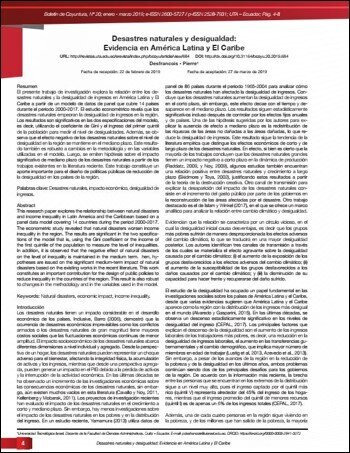Desastres naturales y desigualdad: evidencia en América Latina y El Caribe
Contenido principal del artículo
Resumen
El presente trabajo de investigación explora la relación entre los desastres naturales y la desigualdad de ingresos en América Latina y El Caribe a partir de un modelo de datos de panel que cubre 14 países durante el periodo 2000-2017. El estudio econométrico revela que los desastres naturales empeoran la desigualdad de ingresos en la región. Los resultados son significativos en las dos especificaciones del modelo, es decir, utilizando el coeficiente de Gini y el ingreso del primer quintil de la población para medir el nivel de desigualdades. Además, se observa que el efecto negativo de los desastres naturales sobre el nivel de desigualdad en la región se mantiene en el mediano plazo. Este resultado también es robusto a cambios en la metodología y en las variables utilizadas en el modelo. Luego, se emiten hipótesis sobre el impacto significativo de mediano plazo de los desastres naturales a partir de los trabajos existentes en la literatura reciente. Este trabajo constituye un aporte importante para el diseño de políticas públicas de reducción de la desigualdad en los países de la región.
DOI: https://doi.org/10.31164/bcoyu.20.2019.684
URL: http://revistas.uta.edu.ec/erevista/index.php/bcoyu/article/view/684
Descargas
Detalles del artículo

Esta obra está bajo una licencia internacional Creative Commons Atribución-NoComercial 4.0.
![]()
Las publicaciones del Boletín de Coyuntura están bajo una licencia de Creative Commons Reconocimiento-NoComercial 4.0 Internacional (CC BY-NC 4.0). La Universidad Técnica de Ambato conserva los derechos patrimoniales (copyright) de las obras publicadas, y favorece y permite la reutilización de estas, siempre que: se cite la autoría y fuente original de su publicación, no se usen para fines comerciales u onerosos. La propiedad intelectual de los artículos publicados pertenece a los autores de los mismos.
Citas
Azevedo, J. P., Inchauste, G., Olivieri, S., Saavedra, J., & Winkler, H. (2013). Is labor income responsible for poverty reduction? A decomposition approach. The World Bank.
Baez, J. E., & Santos, I. V. (2008). On shaky ground: The effects of earthquakes on household income and poverty. RPP LAC-MDGs and Poverty-02/2008, RBLAC-UNDP, New York.
Baez, J. E., Rodriguez-Castelan, C., & Fuchs, A. (2017). ¿Desarrollo Económico Inestable? Choques Agregados en América Latina y el Caribe. The World Bank.
Barro, R. J. (2006). Rare disasters and asset markets in the twentieth century. The Quarterly Journal of Economics, 121(3), 823-866.
Bello, O. (2017). Desastres, crecimiento económico y respuesta fiscal en los países de América Latina y el Caribe, 1972-2010. Revista Cepal.
Berry, A. (1998). Poverty, economic reform & income distribution in Latin America. Boulder, Colorado, Lynne Rienner.
Caruso, G., & Miller, S. (2015). Long run effects and intergenerational transmission of natural disasters: A case study on the 1970 Ancash Earthquake. Journal of development economics, 117, 134-150.
Cavallo, E., & Noy, I. (2011). Natural disasters and the economy—a survey. International Review of Environmental and Resource Economics, 5(1), 63-102.
Charvériat, C. (2000). Natural disasters in Latin America and the Caribbean: An overview of risk. Working paper 434, Inter-American Development Bank, Washington DC.
Comisión Económica para América Latina y el Caribe (CEPAL). Panorama Social de América Latina, 2017 (LC/PUB.2018/1-P). Santiago, 2018
Helmer, M & Hilhorst, D. (2006). Natural disasters and climate change. Disasters, 30(1), 1-4.
Ishizawa, O. A., & Miranda, J. J. (2016). Weathering storms: understanding the impact of natural disasters on the poor in Central America. The World Bank.
Islam, S. N., & Winkel, J. (2017). Climate change and social inequality. United Nations, Department of Economic and Social Affairs.
Kellenberg, D. K., & Mobarak, A. M. (2008). Does rising income increase or decrease damage risk from natural disasters?. Journal of urban economics, 63(3), 788-802.
López-Calva, LF and E Ortiz-Juárez (2009). Evidence and Policy Lessons on the Links between Disaster Risk and Poverty in Latin America: Methodology and Summary of Country Studies. Research for Public Policy, MDGs and Poverty, MDG-01-2009, RBLAC-UNDP, New York.
Lustig, N., Lopez-Calva, L. F., Ortiz-Juarez, E., & Monga, C. (2016). Deconstructing the decline in inequality in Latin America. In Inequality and growth: Patterns and policy (pp. 212-247). Palgrave Macmillan, London.
Mendelsohn, R., & Williams, L. (2004). Comparing forecasts of the global impacts of climate change. Mitigation and Adaptation Strategies for Global Change, 9(4), 315-333.
Morley, S. A. (2000). The effects of growth and economic reform on income distribution in Latin America. Cepal Review.
Morris, S. S., Neidecker-Gonzales, O., Carletto, C., Mungu??a, M., Medina, J. M., & Wodon, Q. (2002). Hurricane Mitch and the livelihoods of the rural poor in Honduras. World development, 30(1), 49-60.
Mueller, V. A., & Osgood, D. E. (2009). Long-term impacts of droughts on labour markets in developing countries: evidence from Brazil. The Journal of Development Studies, 45(10), 1651-1662.
Noy, I. (2009). The macroeconomic consequences of disasters. Journal of Development economics, 88(2), 221-231.
Raddatz, C. (2009). The wrath of God: macroeconomic costs of natural disasters. The World Bank.
Skidmore, M., & Toya, H. (2002). Do natural disasters promote long?run growth?. Economic inquiry, 40(4), 664-687.
Székely, M., & Mendoza, P. (2015). Is the decline in inequality in Latin America here to stay?. Journal of Human Development and Capabilities, 16(3), 397-419.
Vakis, R. N. (2006). Complementing natural disasters management: the role of social protection. World Bank, Social Protection.
Yamamura, E. (2013). Impact of natural disasters on income inequality: Analysis using panel data during the period 1965 to 2004. Munich Personal RePEc Archive.


